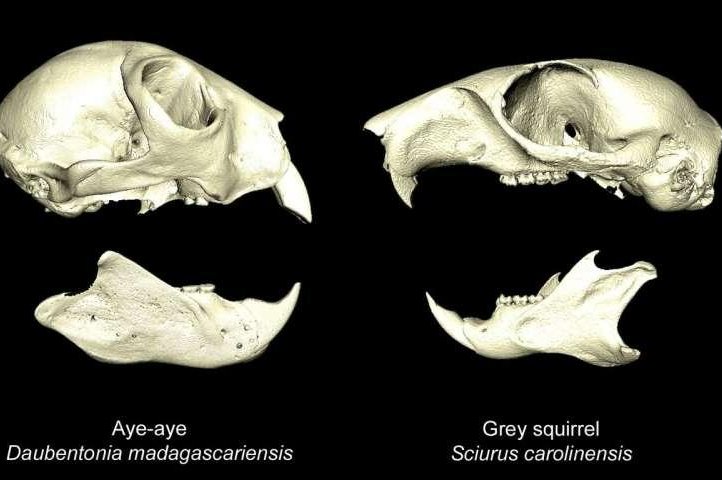Researchers used CT cans to compare the skulls of aye-ayes and squirrels. Photo by Philip Cox/University of York
Aug. 1 (UPI) -- The aye-aye is one the planet's most unusual primates. Thanks to new research, scientists can explain the lemur's unusual features -- its big eyes, large eyes and long, skinny fingers.
As a primate, the aye-aye is most closely related to monkeys, chimps, and humans. But its features recall those of rodents, which is why French explorers classified the species as one when they first observed it in 1780.
By the mid-19th century, scientists realized the aye-aye was a primate, one of Madagascar's many unique lemur species. Today, researchers know the aye-aye's odd features to be examples of convergent evolution -- whereby distantly related species adapt similar features.
New CT scans yielded 3D images of the aye-aye's and squirrel's skeletal structures, helping scientists quantify the level of convergence among aye-aye's rodent-like features.
The analysis -- detailed this week in the journal Biology Letters -- showed squirrels and aye-ayes have developed similar teeth and bite mechanics.
Squirrels use their two front teeth and strong bite to crack nuts. The aye-aye relies on similar features to bite into tree bark in search of wood-boring beetle larvae. In addition to evolving rodent-like incisors, the aye-aye also boasts a squirrel-like skull and jaw.
"Aye-ayes and squirrels have become an iconic example of convergence because of their similar teeth, but our study has shown for the first time that the evolution of their skulls and jaws has also converged," Philip Cox, researcher at the University of York, said in a news release. "Our analysis suggests that the skulls of both species have not evolved simply to house their teeth, but that the distinctive shape may be what allows them to exact a high bite force. The shape of the skull is what makes the aye-aye look so similar to squirrels in particular."
The new research suggests the aye-aye's rodent-like features aren't just similar in two they look, they're also structurally and functionally analogous.
"Our study shows the extent to which functional pressures, such as having to eat mechanically demanding food, can significantly alter an animal's skeleton and result in distantly-related species evolving to resemble one another very closely," Cox said.















